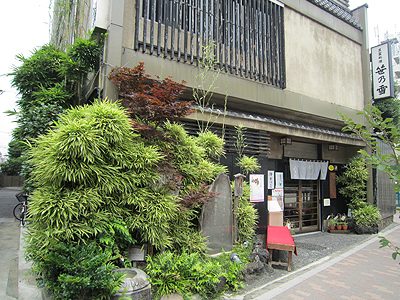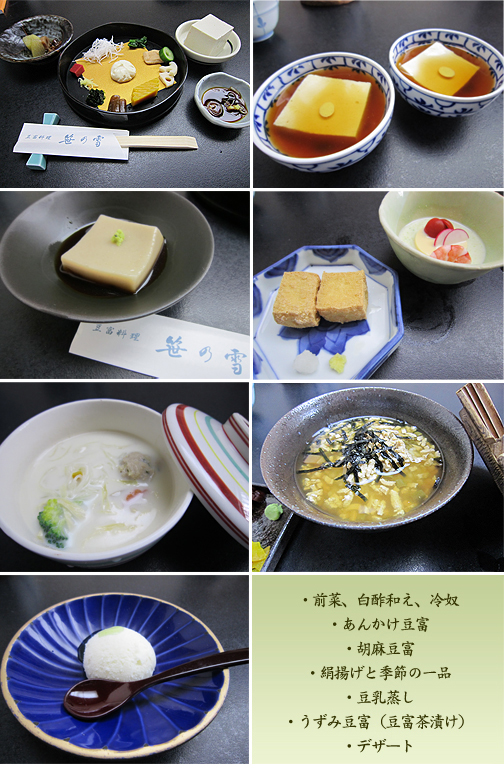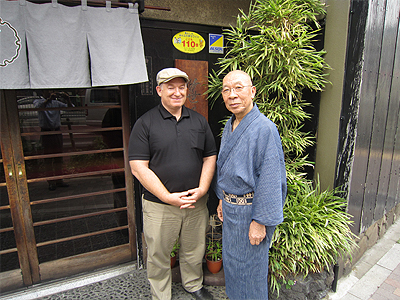【第六十五回目】
笹乃雪:真摯な姿勢で作る絹漉しの「豆富」、江戸から平成へと320年。 Sasanoyuki: 320 Years of Making Silk Tofu
| セインさん。今日、お訪ねするのは、根岸の「笹乃雪」さん。元禄4年(1691)創業の豆富料理の店です。 Thayne-san, today we’ll be visiting Sasanoyuki, a tofu shop founded in 1691. | |
| 「笹乃雪」さんには、以前、友人と食事をしに来たことがあるんです。 それまでに食べたなかで、一番おいしいお豆富でした! だから今日は、どんな話を伺えるのか、とても楽しみにしています。 Oh, I’ve been to Sasanoyuki! I ate there with a friend once. It was the best tofu I’d ever had! I’m really looking forward to talking with the owner. | |
| では、早速お店に入りましょう。 Well, shall we go in? | |
 |
|
| (奥村) | こんにちは、セインさん、コンシェルジュさん。奥村です。 ようこそおいでくださいました。 Good afternoon, Thayne-san and Concierge-san. I’m Okumura. Thanks so much for coming. |
| こんにちは、奥村さん。日本情緒が感じられる、風情のあるお店ですね。 Hello Okumura-san. You have a lovely shop here, just oozing with Japanese atmosphere. | |
| (奥村) | ありがとうございます。 当店の初代は京都の出で、元禄年間に、宮様のお供をして江戸に参りました。宮様は上野のお山にお住まいでしたので、私どもはその山裾にあたる、この根岸の地に居を構えたわけですが、このあたりにはいい水脈が流れていますから、豆富づくりにも絶好の場所だったんです。 Thank you. The first-generation owner was in Kyoto during the Genroku years, but he came to Edo as an attendant to the imperial family. The imperial family lived on a hill in Ueno, so the first-generation owner settled at the base of the hill here in Negishi. This area has a great network of water, so it was the perfect place for making tofu. |
| なるほど。 I see. | |
| (奥村) | しかも上野周辺には800ものお寺がありましたから、おいしい豆富を作れば、どんどん売れた。商売にも都合がよかったんですね。 さらに根岸は、音無川が流れていて、春にはうぐいすが鳴くようなのどかな場所で、文人墨客に愛され、お金持ちの商人たちの別荘などもたくさんありました。豆富屋をやっているうちに、吉原からの朝帰りの粋人たちが、腹が減ったから豆富を食わせてくれ、なんて言って顔を出すようになって……それに応えているうちに、いつしか茶店のような形態の店になっていったようです。 Just in the Ueno area alone there were over 800 temples, so by making good tofu we were able to sell all the priests. It was great for business. The Otonashi River flows through Negishi, and it was very idyllic with the Japanese warblers singing in the springtime. It was loved by writers and artists, and there were a lot of vacation homes for rich merchants. While we were making tofu in the morning, men coming back from the Yoshiwara red light district would poke their heads in and say,“We’re hungry, give us some tofu!” Before we knew it, our tofu shop had become a little teashop of sorts. |
| 作るだけじゃなくて、出来立ての豆富を食べることができる店になっていった、と。 So, your shop not only made tofu, but became a restaurant where you could sit down to enjoy it as well? | |
| (奥村) | はい。いまの外食産業のハシリですね。(笑) ですが、「笹乃雪」という名は、宮様が当店の豆富を「笹の上に積もった雪のように美しい」ということで名付けてくださったもの。つまり、店の名前ではなく、お豆富の名前なのです。ですから、今も昔も、当店は料理屋ではなく、豆富屋です。豆富が作れなくなったら、看板を下ろさなければなりません。 That’s right. The name Sasanoyuki was given to us by the imperial family, who said, “Your tofu is beautiful, like freshly fallen snow on bamboo.” It isn’t the name of the shop, it’s the name of the tofu. So then as now, we’re very much a shop that makes tofu rather than a restaurant. If we couldn’t make tofu, we’d have to close. |
| その真摯な姿勢が、320年近く、お店を繁栄させ、継続させる原動力になってきたんですね。 I guess that dedication has become the force behind your continued prosperity for nearly 320 years. | |
| (奥村) | はい。おいしいお豆富こそが、店の命です。ですから、いろいろな豆富料理を考えてお出ししてはいますが、やはり冷奴と湯豆腐が当店の看板商品です。 It has. Delicious tofu is our lifeblood. So although we create and serve a variety of tofu dishes, chilled tofu and boiled tofu are our specialties. |
| では、セインさん、まずはいただいてみましょう。そろそろお昼の時間ですから。 Well, Thayne-san, shall we eat? It’s about lunch time. | |
| はい、待ってました! That’s what I’ve been looking forward to! | |
 |
|
| ああ、おいしかった! ご馳走さまでした。 このなめらかなお豆富は、絹漉しですか? Ah, that was delicious! Is this smooth tofu kinu-goshi (silk tofu)? | |
| (奥村) | はい、そうです。ちなみに絹漉し豆腐というのは、当店の初代の発明なんですよ。この絹漉しがなかったので、宮様が江戸についてくるように言われたんです。 Yes, that’s right. In fact, kinu-goshi tofu was invented by our first-generation owner. At the time there wasn’t any kinu-goshi in Edo, so the imperial family asked us to move here. |
| そうだったんですか。絹漉し豆富が、この店から生まれたなんて、知りませんでした! 大豆の香りもして、本当においしいお豆富ですが、他にこだわっておられるのは何ですか? Wow, to think that kinu-goshi tofu originated right here in this shop! I had no idea. You can really taste the soybeans in your tofu―it’s so delicious. What other things are important for making good tofu? | |
| (奥村) | やはり、よい水を得ることだと思います。 Having really good water is key. |
| 先ほど、このあたりはいい水流に恵まれているとおっしゃっていましたね。 You said that this area had a lot of good water. | |
| (奥村) | はい、1年を通して15℃から16℃に保たれている、おいしくて豊富な地下水が湧いています。大豆を半日から一日かけてじっくりとふやかすのも、その水ですし、出来上がった豆富を保存するにもその水を使います。適度に冷たい流水の中に豆富を入れておけば、おいしさが変わりません。 以前、突然、井戸の調子が悪くなったとき、やむなく水道水を使ったことがありましたが、適温に保つために何トンという氷を買うことになって大変でした。地下水は、豆富屋の生命線です。 Yes. There’s a large flow of good spring water underground that stays between 15°C and 16°C year-round. This is the water we use to soak the soybeans between one half and one full day, and it’s also the water that the tofu is kept in after it’s made. If tofu is kept in cold running water at the right temperature, the taste will be preserved. Once when we couldn’t get water from the well, we had no choice but to use piped water, but it’s kept at a warmer temperature and we had to buy several tons of ice to chill it. Underground water is the lifeline of a tofu shop. |
| でも、ずっと使っていると井戸が枯れてきませんか。 If you use water from the well constantly, won’t it dry up? | |
| (奥村) | はい。当店の創業の地はここから北へ数分歩いたところで、関東大震災(一九二三年)で倒壊してここに移ってきたんですが、すでに敷地内に6本の井戸があります。 Well, the original shop was a few meters north of here, and when it collapsed in the Great Kanto Earthquake of 1923 we moved to our present location, but there were already six wells on this property. |
| お豆富というのは、地域と密接につながっている食べ物なんですね。あらためて認識しました。 I’m reminded of how intimately connected with the local area tofu is. | |
| ところで、お座敷それぞれに、絵や書の額が飾られていますが、これは代々のご主人が集められたものですか? By the way, I see you have pictures in each of the tatami rooms. Were these collected by the shop masters over the years? | |
| (奥村) | 先祖が集めたものは関東大震災や戦争で失ってしまいましたので、現在ここにあるのは、戦後、集めたものです。買ったものもありますが、芸大の先生方が飲み代の代わりに、さらさらっと描いて置いて行かれたものなどもありますよ。 Most of the collections by my ancestors were destroyed in the Great Kanto Earthquake or in the war, so everything you see here we have gotten after the war. Some of them we bought, but others were given to us by professors of the Tokyo University of the Arts. They drew them quickly and left them as payment for their drinks. |
| いい時代があったのですね。それにしても、戦争で焼けてしまったのは、惜しかったですね。 Those were the days! But it’s really too bad the original collections were lost in the war. | |
| (奥村) | ええ、持って逃げることができたのは宮様からいただいた「笹乃雪」の看板と仏壇くらいのものです。戦後しばらくは、焼き鳥やアイスキャンディを売ってしのいだ時代もあったんですよ。 Yes, the only items that the family was able to take with them when escaping were the Sasanoyuki sign and our family Buddhist altar. For a while after the end of the war, we sold yakitori and popsicles to get by. |
| いろいろなことがあったんですね。 You’ve faced a lot of challenges. | |
| (奥村) | はい、本当にいろいろと。 そうそう、宮様が「笹乃雪」と書いてくださった店名額が玄関にかけてあります。300年という月日のなかで墨の色もあせ、見えるかどうか、というくらいになってしまっていますが、よろしければ帰りにご覧になっていってください。 Yes, quite a lot. Oh, I almost forgot. The Sasanoyuki sign painted by the imperial family is hanging in the entrance. Over the 300years that have passed, the ink has faded and it’s hard to read, but if you’d like, have a look on your way out. |
| はい。そうします。 今日はありがとうございました。 We will. Thank you so much for your time today. | |
 |
|
| (文)太田美代 (英訳)デイビッド・A・セイン |
 1959年、米国生まれ。翻訳家、通訳、英会話経営者(エートゥーゼット英語学校)。カリフォルニア州アズサパシフィック大学で社会学修士号取得。証券会社勤務を経て来日し、多岐にわたって活躍中。
1959年、米国生まれ。翻訳家、通訳、英会話経営者(エートゥーゼット英語学校)。カリフォルニア州アズサパシフィック大学で社会学修士号取得。証券会社勤務を経て来日し、多岐にわたって活躍中。豊富なアイディアと行動力、そして誠実な飾らぬ人柄も万人に愛されている。
著書に『その英語、ネイティブにはこう聞こえます』(主婦の友社)、『使ってはいけない英語』(河出書房新社)、『英語ライティングルールブック』(DHC)、『英語でしゃべらナイト』(NHK出版)など多数。『Mainichi Weekly』(毎日新聞社)の連載や『水は答えを知っている」(The Hidden Messages in Water)等の翻訳も好評。 http://www.smartenglish.co.jp/
最新記事
This post is also available in: Japanese







